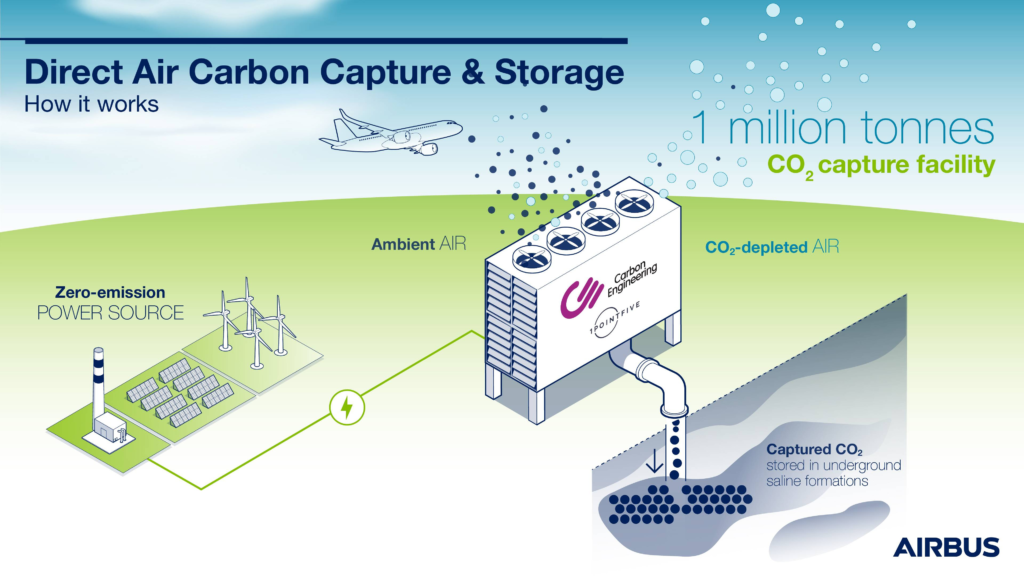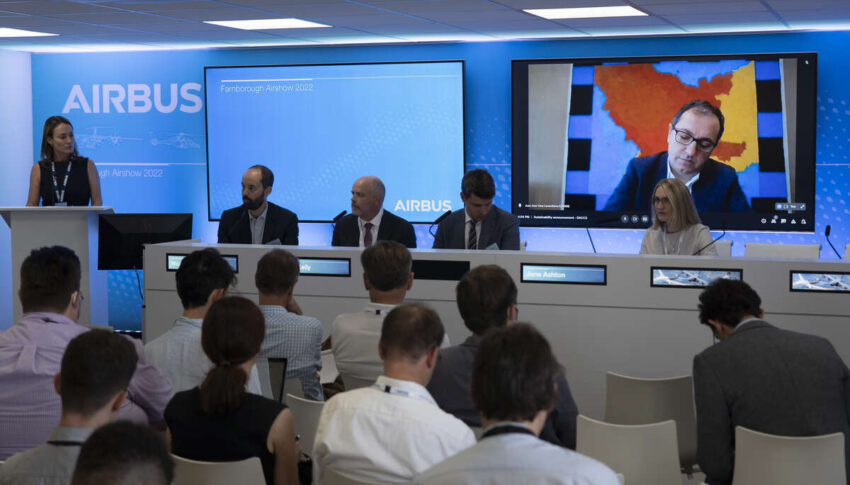Airbus and a partnership of airlines and airline groups comprising more than a dozen worldwide carriers are working together on a new carbon capture project, with the aim to provide secure, verifiable carbon removal credits as part of aviation’s need to offset part of its future emissions.
Announced at the Farnborough Airshow, the partnership spans Air Canada, Air France-KLM, easyJet, International Airlines Group (the parent of British Airways, Iberia, Aer Lingus and Vueling), LATAM Airlines Group, Lufthansa Group (including Swiss, Austrian, Brussels and the Eurowings brands) and Virgin Atlantic.
The methodology from Carbon Engineering involves direct air carbon capture and storage, or DACCS. At a basic level, high-powered fans suck air in, process it, then compress it into liquid and store it in underground geologic reservoirs.
The agreement is at this point an early stage partnership, based on letters of intent, and the airlines have “committed to engage in negotiations on the possible pre-purchase of verified and durable carbon removal credits starting in 2025 through to 2028”.
This gives a fairly substantial amount of wiggle room, but is intended to cover a pre-purchase total of some 400,000 tonnes of removal credits. Airbus partner 1PointFive, a subsidiary of Occidental Petroleum’s Low Carbon Ventures business, will issue the carbon credits as early as 2025.
To give an idea of scale here, in 2019 British Airways alone reported that it emitted over 19m tonnes of CO2 equivalent from just scope 1 emissions, which the carrier defines as “direct emissions associated with British Airways operations including use of jet fuel, diesel, petrol, natural gas, and halon. Sources of emissions include aircraft engines, boilers, auxiliary power units and ground vehicle engines”. [PDF]
That makes this agreement approximately 2% of BA’s annual scope 1 emissions alone, and there are questions as to the extent to which this technology can scale, as well as how it is powered and its own sunk carbon costs.
Yet commitment, investment certainty, technological discussion and even making an announcement at a major event like an airshow — with airframer and indeed airlines — is part of a showing willing that is itself a positive move as aviation hustles to meet its net zero commitments. It also allows the industry to agree on some options before approaching key regulators for approval.
Indeed, as Air France-KLM vice president for sustainability Fatima da Gloria de Sousa explains, “the letter of intent we are signing with Airbus today embodies the collaborative approach the aviation industry has initiated to find effective solutions that meet the challenge of our environmental transition. Only together can we address the climate emergency.”

We had the chance to quiz executives from Airbus, the airlines and their carbon capture partners, and asked Airbus head of marketing Stan Shparberg about precisely that level of concreteness around the project.
“On a small scale, it’s the technology that’s been proven. We now basically need to scale it up, and that’s what Steve and the team at 1PointFive are going to be doing,” Shparberg tells us. “On our side, together with our partners and customers, we need to make sure that it’s recognised by the regulators. So this is where the coalition comes together to really ensure that we get the recognition for it.”
Shparberg tells us that the plans are “very concrete, and the plant is supposed to be up and running in 2025. So it’s not a very hypothetical discussion here, [or an] ‘if and when’. This is something that we’ve embarked on. Of course, there’s a number of milestones that we need to achieve to get to the final result.”
Standards, transparency and verification remain key issues
We raised the question of how the scheme will be standardised, transparent and verifiable with 1PointFive president and general manager Steve Kelly.
“That’s all taken care of, under the verification methodologies that [are] agreed with the authorities in the United States already,” Kelly tells us. “That’s really well advanced. Our understanding of the behaviour of CO2 underground in underground reservoirs is very, very well advanced: we’ve been handling CO2 as a company for over forty years now. So there’s no there’s no issue with the verification or the carbon scoring.”
More widely on the subject of verification, Nicolas Chretien, group head of sustainability and environment at Airbus, tells us, “I think what we need to develop is that verification to international standards, to establish a standardisation scheme for acceptance of DACCS, defining sustainability criteria.”
While work is underway by the usual suspects such as ISO, there are key individual questions about this particular technology when it comes to carbon scoring and carbon accounting.
“How do you assess for instance, the lifecycle impact of the overall process?” Chretien asks rhetorically. “Obviously, you have that process needs to be sourced with renewable electricity… if you want a negative emission in that process.”
Indeed, the week after the airshow the UK government announced a call for evidence on its open consultation as it looks to create a policy framework for power with carbon capture, usage and storage.
“What we’re looking at actually — and that’s the approach that is taken also by the Science Based Targets Initiative — is [that] we believe that there is additional value in removals because they’re affected by nature. And we could look at those removals as ways to actually contribute to net zero plans of companies, namely Airbus and our airline customers as well,” Chretien tells us. “But then, in this case as well, you need to assess how this removal — because it’s a reduction of CO2, an out-of-sector one — could still fit decarbonisation plans or reduction schemes. If you look at the EU ETS, for instance, in Europe, the question will be, ‘how would this be dealt with?’”
These questions get even more complicated if, as was raised during discussions, some or all of this captured carbon could be transformed into more sustainable fuels through emerging processes. And that is, fundamentally, key to this project and others. Direct air capture is just one of the levers that aviation can and must pull along its decarbonisation journey to net zero.
Author: John Walton
Published 2nd August 2022




